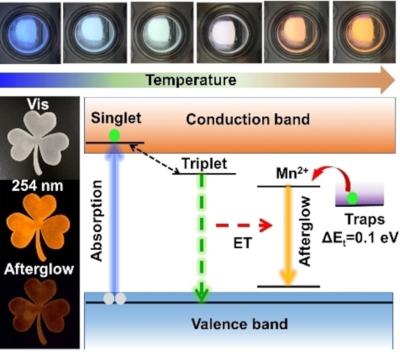An international research group, led by Dr. Yang Bin from the Dalian Institute of Chemical Physics (DICP) of the Chinese Academy of Sciences (CAS), has developed cadmium (Cd)-based perovskite single crystals with long afterglow and high luminous quantum yield, and investigated its afterglow luminescence dynamics mechanism.
Afterglow materials have the ability to store multiple radiations such as visible photons, ultraviolet rays, and X-rays. They are widely used in display, biological imaging, anti-counterfeiting technology, and data storage. However, traditional all-inorganic phosphors, such as oxide, sulfide, and nitride-based afterglow materials, have high lattice energy and usually need to be produced by high-temperature processing (>1000°C), which brings considerable energy consumption and safety risks to production and preparation.
Using solution-processed perovskite CsCdCl3 single crystal as the afterglow matrix, the researchers proposed a luminescence strategy based on energy transfer from triplet self-trapped excitons (STE) to the acceptor Mn+ through Mn2+ doping. They developed a high-efficiency ultra-long anti-thermal quenching afterglow emitting phosphor, which could simultaneously achieve high luminescence quantum yield (81.5%) and ultra-long afterglow time (150 seconds).
Moreover, they provided clear evidence for the luminescence mechanism through in-depth carrier dynamics studies and density functional theory (DFT) calculations. They found that the CsCdCl3Mn2+ structure had [CdCl6]4- octahedron with plane symmetry (C3v symmetry) and angular symmetry (D3d symmetry) nature, which could form inequivalent Cl vacancies, and result in trap states with a broad energy distribution.
"We found that these trap states can store charge carriers and slowly release them to the emission center ([MnCl6]4- octahedron), resulting in afterglow emission with anti-thermal quenching effect," said Dr. Yang.
Other researchers on the team come from Denmark's University of Copenhagen, Sweden's Lund University and China's Shandong University.


